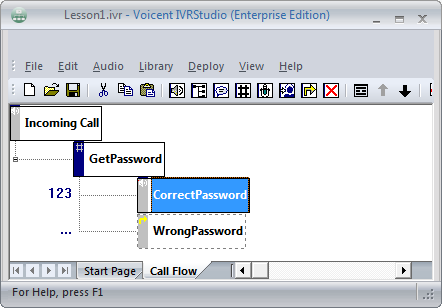IVR Tutorial Lesson 1: Test Lesson 1
Once deployed, you can call in to test the application. The following is a typical session:
- Caller: call in
- IVR: answer the call
- IVR: "Welcome to my broadcast service. Please enter your password followed by the pound key"
- Caller: 1234#
- IVR: "Your password is incorrect"
- IVR: "Welcome to my broadcast service. Please enter your password followed by the pound key"
- Caller: 123#
- IVR: "Your password is correct"
- IVR: disconnect call
What's behind the scenes
The following explains how the IVR application controls the interactions.
- Caller: call in
- IVR: answer the call
-Incoming Call element is active. No action to take, transition to Get Password element. - IVR: Welcome to my broadcast
service. Please enter your password followed by the pound key
-Get Password element is active. First the program will play all defined prompt items. Since it is a digits element, it waits for caller input. - Caller: 1234#
- IVR: Your password is incorrect
-Since the condition of the first transition (equals 123) is not satisfied, the second transition is used. The condition of the second transition is "...", which matches any input. The second transition changes the active element to Incorrect Password. The prompt of that element is played. Since it is a jump element, it will transition the active element to the target element (Get Password). - IVR: Welcome to my broadcast
service. Please enter your password followed by the pound key
-Get Password element is active. First play all defined prompt items. Since it is a digits element, it waits for caller input. - Caller: 123#
- IVR: Your password is correct.
-The condition of the first transition is satisfied, the active element now is Correct Password. The prompt of the element is played. - IVR: disconnect call.
-No more transitions are defined.
The Application
The application so far: Lesson_1_Call_Flow.zip
Video: IVR Call Flow Design

